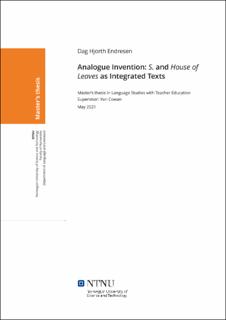| dc.description.abstract | Since the turn of the millennium there has been an emergence of novels that incorporate unorthodox page design as part of their narrative toolbox, some of which have acquired a cult following that still comb through their atypically designed pages. This thesis provides a qualitative study of modern publications that use digital typesetting to produce an untraditional analogue experience. The contemporary materialist field is often primarily concerned with hypertexts and other forms of digital literature, while this thesis is focused on the potential still present in physical books.
Because categorization of this kind of atypically designed book is lacking, I suggest the term “integrated texts” to describe them. The definition of this term as well as a general description is provided in chapter 1. Chapter 2 and 3 will provide case studies of Danielewski’s House of Leaves and Abrams & Dorst’s S. to illustrate how integrated texts work. Both of which remediate their themes through multiple levels of storytelling but through drastically different techniques. House of Leaves’s ludic text making and experimental page design look nothing like S.’ marginalia and use of paratextual inserts, but both are examples of integrated text. This thesis argues for the aesthetic potential in moving beyond the traditional borders of the page. | en_US |
